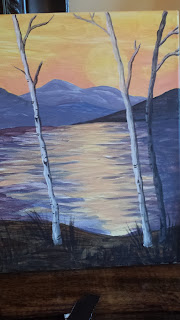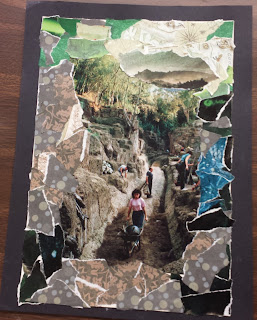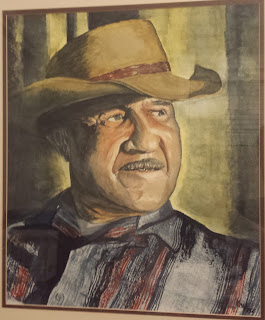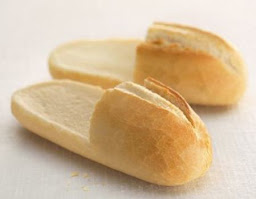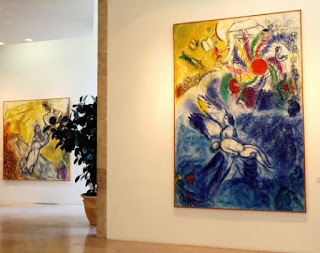Some of my favorite artists -- Franz
Marc, Henri Matisse, and Vincent Van Gogh -- were famous for
painting with primary colors: red, yellow, and blue. I'll introduce the color, then highlight my Top 5 favorite
compositions in each of the three primary color categories.
RED
 |
| Bison, Altamira in Spain, (c. 15,000-16,500 BC) |
Let's start with the color red, which is the dominant color in many of the highest-priced paintings. Its use began as early as pre-historic times in cave paintings using hematite-based ochre, then toxic cinnabar in ancient Egyptian times. Up until the Protestant Revolution red was very popular. Other sources of red pigment were minium, vermilion, cadmium, and carmine, which was made from cochineal bugs.
 |
| Portrait of Agostino Pallavicini, van Dyck (1621) |
Vermilion red was popular with Titian, while J.M.W. Turner, Rembrandt, Rubens, van Dyck, Vermeer, Thomas Gainsborough, and Sir Joshua Reynolds preferred carmine red. Henri Matisse used cadmium red and even encouraged his friend, Renoir to use it as well, but apparently, he was too resistant to change. Later, abstract expressionists such as Jackson Pollock and Mark Rothko used Lithol red.
1. J.M.W. Turner’s The Scarlet Sunset (1833)
Turner painted amazing atmospheric effects. Many of the images of this painting that I've seen on the Internet show the red as much more vibrant than is seen in this photo. I would love to see this particular painting in-person at a gallery.
2. Henri Matisse’s The Dessert: Harmony in Red (1908)
What I like about Matisse is his boldness, not only in his use of color but in his unabashed usage of large patterns that cover walls and tables in his compositions. Even the window or large framed landscape is oversized. His areas of color create a space that is nearly free of perspective relying almost solely on the juxtaposition of color against color. I could go on and on about this painting...
3. Jackson Pollock’s Red and Blue, 1943
As you may already know, I love abstract expressionist paintings. I also love finding lesser-known paintings that are departures from the famous paintings done in an artist's familiar style. While I love Pollock's drip paintings, this one speaks loudly to me.
4. Helen Frankenthaler’s Carousel painting (1979)
Maybe it's the size of this work that impressed me when I saw it this year at the Palm Springs Art Museum. It was hung on an upstairs wall next to a narrow walkway such that I couldn't step back to view it properly. Therefore, it was like I was drawn into it. In another post, I contrasted Frankenthaler's softer (impasto) style against Pollock's bolder, layered (impasto) style. While I love drip paintings, I prefer the almost watercolor effect that Frankenthaler achieves in her expressionist works.
5. Georgia O'Keeffe's Red Canna paintings (1924).
Who can resist looking at a flower close up? While we know O'Keeffe painted soft New Mexico landscapes, she is probably best known for using line and color to draw us into her rich flower paintings. There are many versions of similar paintings, some accented in black and other with pale lavender tones. I appreciate her use of the color red.
YELLOW
 |
Lascaux Cave Painting (c. 17,000 BC)
|
As far as the color yellow, again ochre was used, and lead-tin yellow was also popular. There are some very obvious choices for paintings that are prominently yellow or yellow-orange or gold. Three of my five favorites were painted by Van Gogh. He suffered from epilepsy, which was treated with digitalis and known to cause patients to see yellow.
1. Van Gogh's Café Terrace at Night (1888).
Van Gogh effectively uses bright yellow with the help of blue and orange to achieve his focus on the awning of the outdoor restaurant. He also painted the interior of The Night Café in the Place Lamartine in Arles, complete with red walls and yellow floor.
2. Van Gogh's Sunflowers (1888).
This must be on my list because it is a classic and I enjoy sunflowers. We currently have about six large pots of sunflowers growing very tall up to our 2nd-floor deck. Van Gogh painted a series of 12 sunflower paintings, including 5 in Paris prior to this one, and 7 more (along with this one) while in Arles from 1888-89. I was pleasantly surprised to see it at the National Gallery in London when we visited the UK in June of 2017. Like the Mona Lisa (in the Louvre), it was smaller than I had expected, yet no less impressive.
3. Gustav Klimt's The Kiss (Lovers) (1907-08).
This is also a classic, as is his portrait of Adele Bloch-Bauer I (1907). I believe this painting has been recently restored. It is immediately recognizable due to Klimt's intricate patterns and yellow hues. The embracing figures are modestly hidden, their hair becoming part of the floral background. The composition unifies the green and yellow color fields with smaller orange and purple areas that hug the woman's body and leading upward toward the kiss.
4. Van Gogh's The Yellow House (1888).
This painting holds a special place in my heart because of the story behind it. Apparently, Van Gogh had hoped to establish a “Studio of the South” where he could invite his friends to come and paint together. He occupied four rooms, identified by the green shutters, from May 1888 until his tragic death the following year.
5. Franz Marc's The Yellow Cow (1911).
This is a whimsical painting of a frolicking cow. Marc loved to paint animals, including red and blue horses. He and Kandinsky were part of the Blue Riders group who used color symbolism. Yellow symbolized femininity and sensuality.
BLUE
 |
| Tomb painting dated to the reign of Ka-Sen |
Now to the cooler color, blue. One of the oldest blues is Egyptian blue from over 5,000 years ago. Today, we see lots of blue in landscapes and seascapes for the traditional color of the sky and water. Salvador Dali used it as a contrast to his orange in his Persistence of Memory. Other artists successfully used blue to convey a more somber, melancholy mood, such as the paintings of Picasso's Blue Period (1901-04).
1. Pablo Picasso’s The Old Guitarist (1903-04).
I love showing this painting to my students. Once I used MS-PowerPoint animation to rotate the picture on its side, then asked my 3rd-graders which way they thought the painting should be presented and which position felt more comfortable for the old man.
2. Van Gogh's The Starry Night (1889).
This is yet another classic that I cannot ignore. It's all at once magical and mystical and yet somehow sad, knowing about Vincent's turbulent struggle. The circles or halos around the stars is likely a sign of Van Gogh's lead poisoning from the paint he used. I painted something similar with my daughter and niece at a Paint Night where we thinned out white acrylic paint and flicked our brushes to get the starry effect. I've always loved his cypress trees too and often borrowed a small petrified potted version to use as a prop when I taught about Van Gogh.
There's a wonderful video of Don McLean's Starry, Starry Night accompanied by many of Vincent's works. I often show it to my 5th- and 6th-graders as a special treat. My 6th-graders had a substitute teacher who for a bit allowed his students to sing along until they got too silly.
3. Thomas Gainsborough The Blue Boy (c. 1770).
Probably Gainsborough's most famous painting was this homage to van
Dyck, who had painted several portraits of Charles II as a boy, although Gainsborough's subject was not of royal lineage. My elderly neighbor in New Jersey -- Mrs. Margaret Holscher -- had an opulently decorated drawing room including a
copy of Gainsborough’s Blue Boy. I recall this room was just past the front
door entryway. It led straight out to her patio, where her brother, 'Uncle George' was often sitting. To the left up a couple of stairs was her kitchen. She loved
making Chicken Cacciatore and gave me her recipe. I was probably 12 or 13.
When I posted about Port Townsend, WA, you may recall that we happened on a pair of needlepoint portraits (after Gainsborough's Pink Lady and Blue Boy) hanging in one of the officer's houses.
4. Henri Matisse's Blue Nudes Series (1952).
It's simply several blue shapes on a grayish background. Very effective! These nudes are typically displayed together as a series when exhibited in a gallery setting. I recall a similar Matisse work of a sailboat and its reflection that for 47 days hung upside down at the MOMA before anyone noticed. This apparently happened in October 1961 not long after the exhibit opened.
5. Chagall's In My Country (1943).
Marc Chagall is one of my favorite artists. I was lucky enough to visit his museum while in Nice, France in May 2011. Henri Matisse also has a museum there. What was most impressive was the size of Chagall's paintings, which took up entire walls in the large rooms of the museum.












